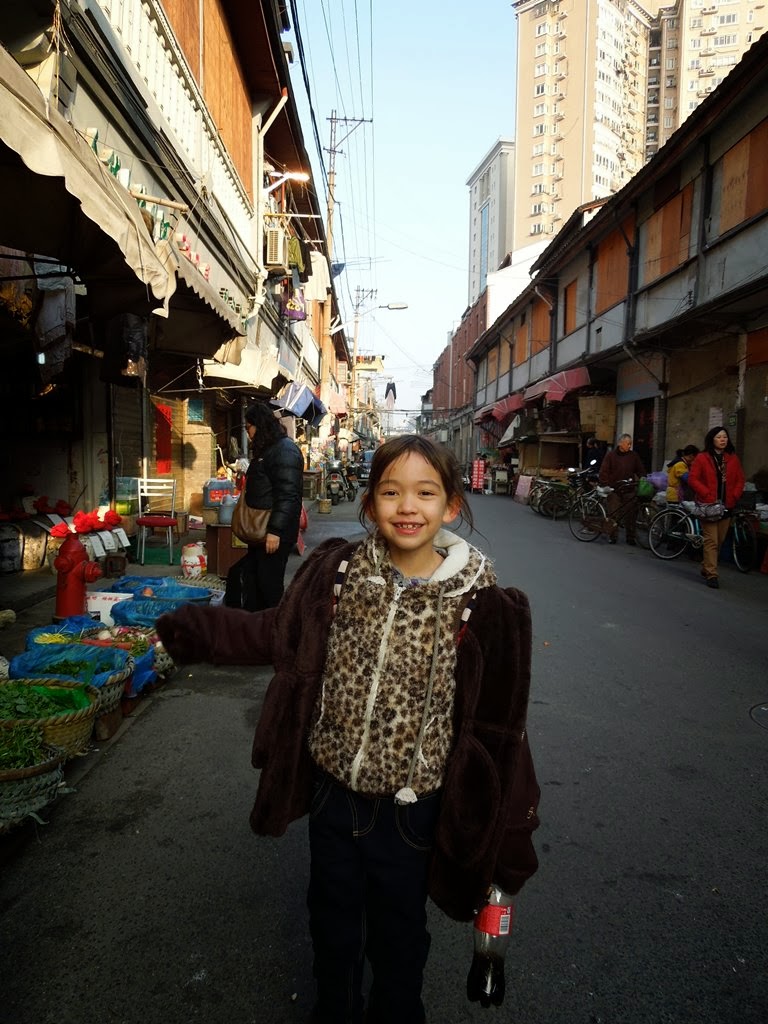My daughter models her finest Spring Festival 春节 duds
A Happy Lunar New Year (I hesitate to use the word "Chinese" in deference to our Korean and Vietnamese friends) to you all as today marks the beginning of the Year of the Horse. It sounded like a war zone outside our home yesterday evening with all the firecrackers and fireworks going off, and the detritus was everywhere to be seen on the ground today. As this will be our first Spring Festival in China, over the next few days it will be interesting to see how the holiday is observed here compared to Taiwan.
One thing both places have in common is that the sightseeing spots will be extremely crowded, aka 人山人海. The photo above was taken in Qībăo 七宝, a so-called "water town" that lies within the Shànghăi 上海 city limits. I had already visited the area last year on Columbus Day, but my wife suggested going again this afternoon. The most direct way for the us to get there was by bus, a short but jarring ride (the driver was apparently never taught how to gradually accelerate and decelerate) highlighted by a shouting match between a middle-aged woman who had tried to hold a vacant seat for her elderly father and another elderly gentleman who managed to get to it first. Never a dull moment in China.
Amber displays a sweet confection known as huàtáng 画糖, which you may notice has been formed into the shape of a rabbit (at my daughter's request). The look on the old woman's face probably sums up how it feels to have to battle the hordes everywhere you go during the holidays. As an outsider, it's easy to stand to the side and be amused by the situation, knowing you only have to put up with this for the relatively short time you're going to be in the country (plus it's easier to just go abroad during peak Chinese travel periods). But until the average Chinese worker can be assured that he/she will be able to take their allotted vacation time at their jobs without fear of retribution, most people will have no choice but to utilize the three long holiday periods (the Lunar New Year, May Day and the national day holiday on Oct. 1) to hit the road and see the sights of their vast country.

Places like Qibao are no more than glorified excuses to buy cheap souvenirs and gorge on snack foods.
Speaking of which, my wife decided that she absolutely had to have a wooden back scratcher.
This small stretch of canal is why Qibao is known as a "water town". A number of such settlements that have learned how to rake in the tourist 元 can be found in the greater Shanghai area.
Pamela encouraged me to take a picture of this teahouse because of the architectural style of its roof, but barbarian that I am, I couldn't really appreciate the significance of it.
The quest for snacks is a never-ending one
My daughter loves quail eggs. Stacked behind her are piles of chicken meat wrapped in "dirt", as my wife describes it.
Pamela purchased some chicken stomachs from this food stand (they weren't bad, actually).
茄子!
A closer look at what you can see in the background in the above photo of Amber and me.
A quieter side entrance. Something to remember the next time we visit Qibao.
Banging the drum slowly. I'm not sure why there is a dated reference to the 2010 World Expo, which was held in Shanghai that year.
New Year decorations outside one of Shanghai's many huge shopping malls. Pamela wonders why there aren't any such temples of consumption in our neighborhood, but I doubt our wealthy neighbors would want the proletariat rabble such places no doubt attract.
The first day of our Lunar New Year holiday finished with my wife's favorite choice for dinner - hotpot 火锅. The bus ride home was a lot less dramatic, though we still had to hold on for dear life so as not to go sprawling in the aisle.
新年快乐!







































.JPG)





















